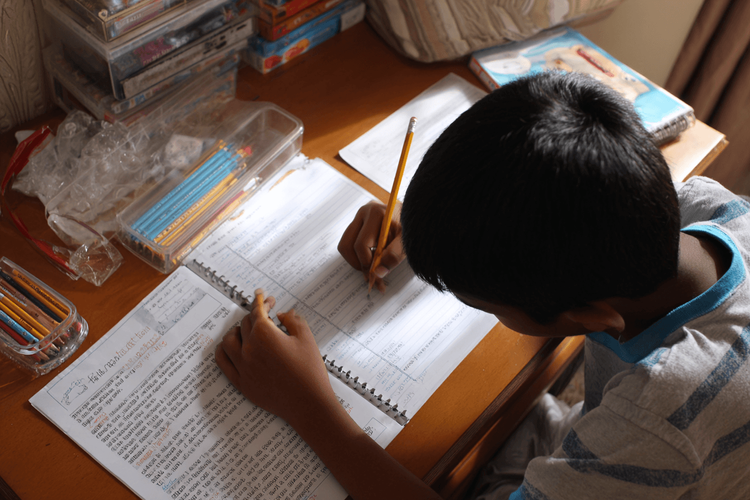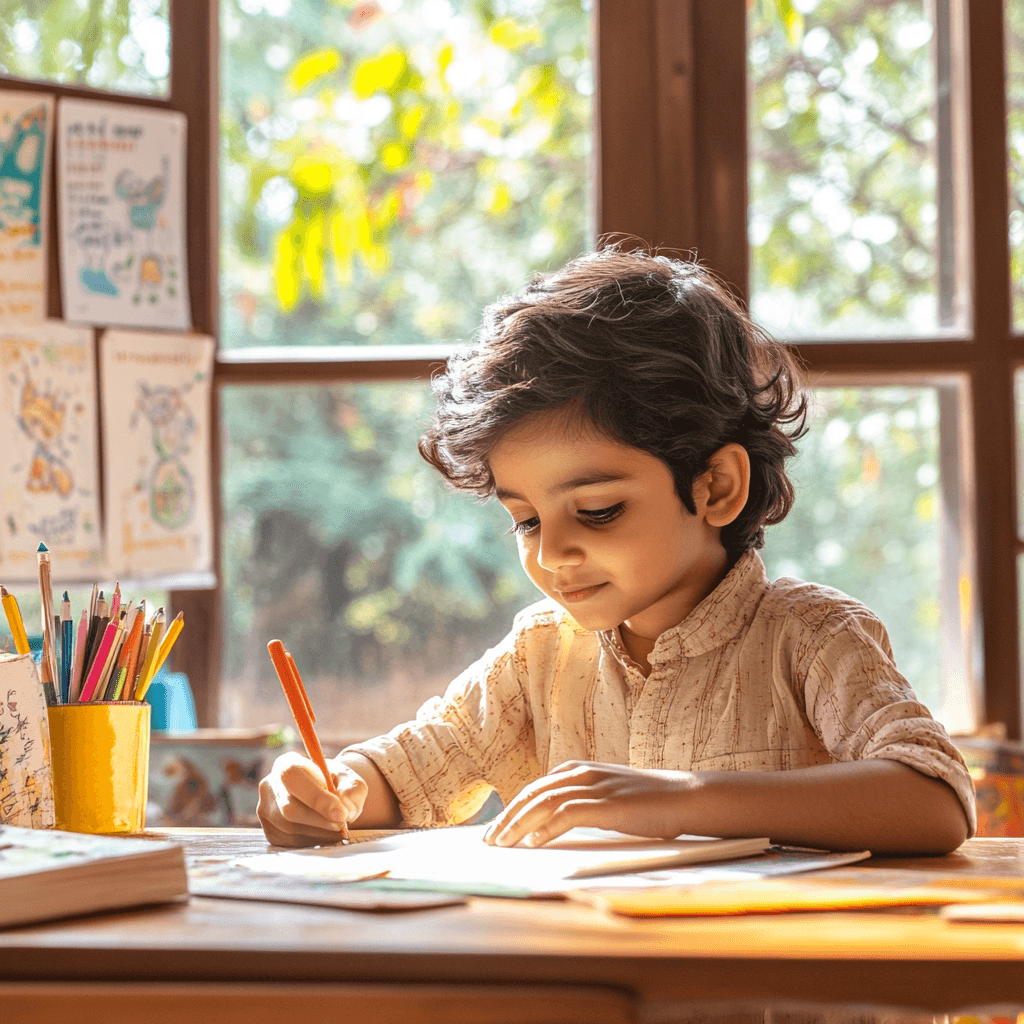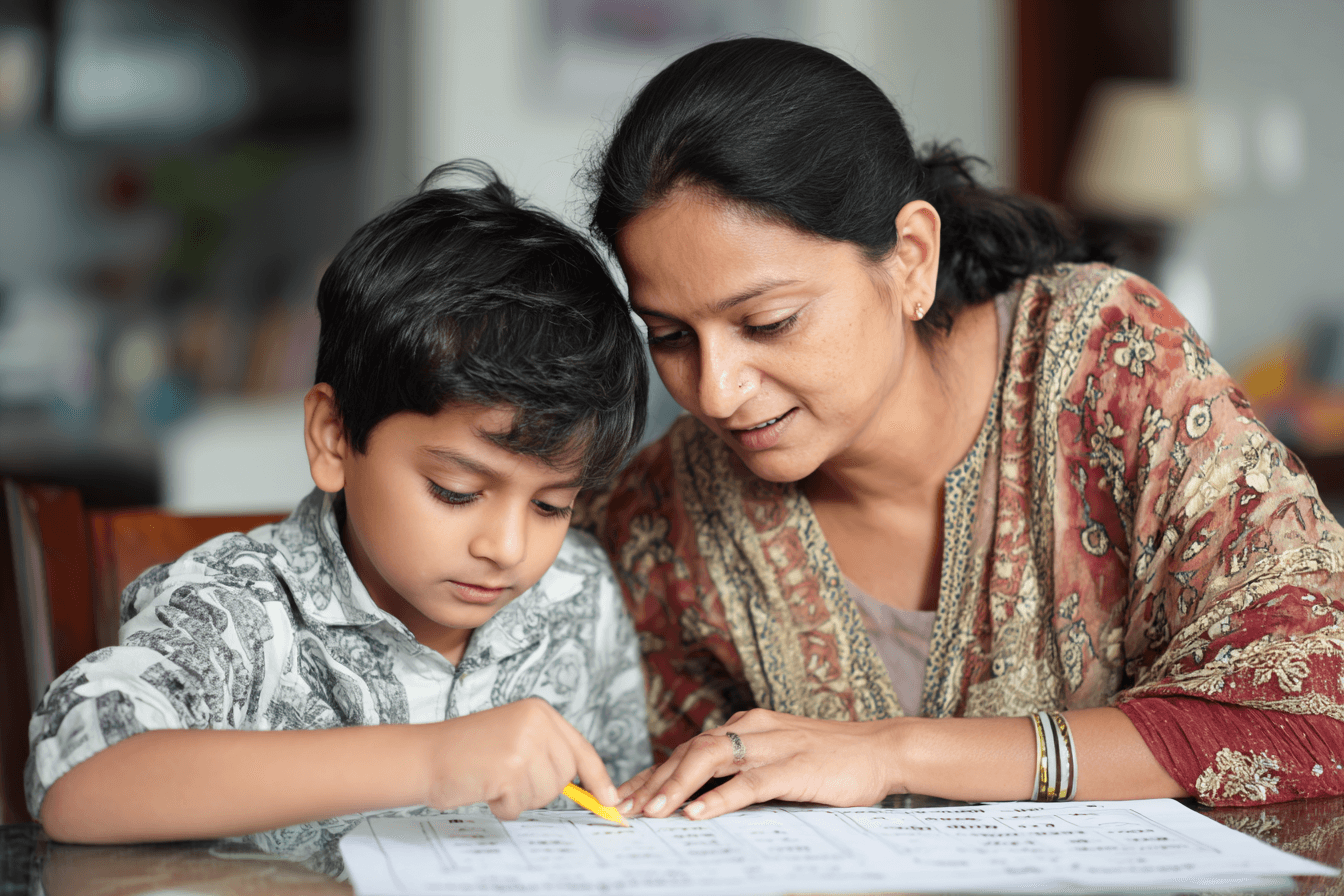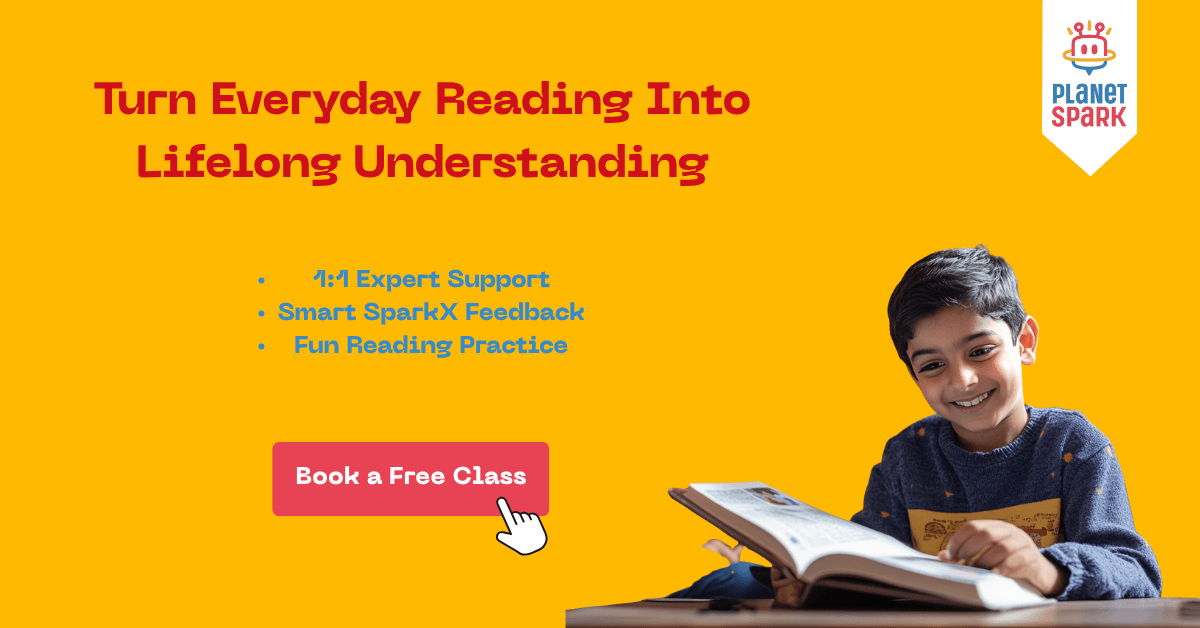Unseen Passages for Class 2: Improve Reading & Comprehension

Table of Contents
- Unseen Passages for Class 2 with Questions and Answers
- Why Are Unseen Passages Important in Class 2?
- Tips to Solve Unseen Passages in Class 2
- Common Question Types in Class 2 Unseen Passages
- How Parents Can Support at Home
- Common Challenges in Solving Unseen Passages (Class 2)
- How PlanetSpark Helps Build Strong Reading Comprehension Ski
- Conclusion
- FAQs About Unseen Passages for Class 2
Reading comprehension is the cornerstone of strong language skills. For Class 2 students, regular practice with unseen passages helps improve vocabulary, grammar, and understanding. Whether your child is just beginning to read fluently or preparing for school assessments, unseen comprehension passages can make all the difference.
Reading comprehension is a skill every child needs, and PlanetSpark is here to support that journey from the very beginning. In this blog, explore handpicked unseen passages for Class 2 with questions and answers, along with expert tips to build strong comprehension skills.
Unseen Passages for Class 2 with Questions and Answers
Below are 10 engaging and age-appropriate unseen passages for Class 2. Each passage is followed by simple comprehension questions to help your child improve reading skills and build confidence.
Passage 1: The Picnic Day
One Sunday morning, Aryan and his family went for a picnic in the park. They packed sandwiches, fruits, and juice in a basket. Aryan took his football to play. When they reached the park, they spread a mat under a tree and sat down. After eating, Aryan played with his father while his mother read a book. Birds chirped in the trees, and the cool breeze made the day pleasant. They came home in the evening, tired but very happy.
Questions
- Where did Aryan and his family go?
- What did Aryan take with him?
- What did his mother do at the park?
- How was the weather?
- How did they feel at the end of the day?
Answers
- They went to the park for a picnic.
- Aryan took his football.
- She read a book.
- The weather was pleasant and cool.
- They felt happy and tired.
Passage 2: The Busy Ant
Riya saw an ant carrying a grain of rice on its back. The grain was bigger than the ant, but it did not stop. It walked slowly and carefully along the garden path. Other ants followed it, each carrying food. Riya watched them for a while and was amazed at how hard they worked. She did not know ants worked in teams and helped each other. That day, she decided to work hard like the ants and help her mother at home.
Questions
- What was the ant carrying?
- What did Riya learn?
- What surprised Riya?
- Who did Riya decide to help?
- How were the ants working?
Answers
- It was carrying a grain of rice.
- Riya learned to work hard and help others.
- She was surprised by how hard ants worked together.
- She decided to help her mother.
- The ants were working as a team.

Let your child master reading comprehension with ease.
Passage 3: The Rainy Morning
It was a rainy morning. The sky was grey and the wind was blowing. Rohan wore his yellow raincoat and stepped out with an umbrella. On his way to school, he saw frogs jumping and puddles everywhere. The streets were wet, and the trees danced in the wind. Rohan reached school safely and dried his shoes near the classroom heater. He liked rainy days because they made everything look fresh and clean.
Questions
- What colour was Rohan’s raincoat?
- What did he see on the way to school?
- How did he dry his shoes?
- What did the trees do in the wind?
- Why did he like rainy days?
Answers
- It was yellow.
- He saw frogs and puddles.
- He dried his shoes near the heater.
- They danced in the wind.
- He liked them because everything looked fresh and clean.
Passage 4: The Helpful Girl
Meera was walking home from school when she saw an old woman trying to cross the road. The traffic was busy, and no one stopped to help. Meera quickly went to the woman and asked if she needed help. Holding her hand, Meera helped her cross the road safely. The woman smiled and thanked her. Meera felt happy. When she told her mother about it, her mother hugged her and said she was proud of her.
Questions
- Who did Meera see?
- What was the problem?
- How did Meera help?
- What did the woman do after crossing?
- How did Meera’s mother react?
Answers
- She saw an old woman.
- The woman was unable to cross the road.
- Meera helped her cross the road.
- She smiled and thanked Meera.
- She hugged Meera and said she was proud.
Passage 5: The Lost Puppy
One evening, Anya heard a soft sound near her house. She looked outside and saw a little brown puppy sitting near the gate. It looked hungry and scared. Anya gave it some milk and a warm cloth to sleep on. The next morning, she and her father put up posters to find its owner. By evening, a boy came and said it was his puppy named Bruno. He was very thankful to Anya for taking care of it.
Questions
- What did Anya see outside?
- What did she give the puppy?
- Who helped Anya put up posters?
- What was the puppy’s name?
- How did the boy feel?
Answers
- She saw a brown puppy.
- She gave it milk and a cloth.
- Her father helped her.
- The puppy’s name was Bruno.
- He was thankful.
Passage 6: The Treehouse Adventure
Ravi and his cousin Tara spent their summer holiday in their grandparents’ village. One afternoon, they discovered a wooden treehouse in the backyard. It had a ladder, two small windows, and a door made of bamboo. The treehouse was dusty, so they cleaned it together and brought some books, pillows, and snacks. Every day, they played games, read stories, and watched birds from the little windows. Sometimes, their grandfather joined them and told tales of his childhood. They loved the peaceful view of the green fields and the sound of rustling leaves. On their last day, they wrote a note and left it in the treehouse. The note said, "Thank you for the best summer ever."
Questions
- Where did Ravi and Tara spend their holiday?
- What did they find in the backyard?
- How did they use the treehouse?
- Who told them stories?
- What message did they leave behind?
Answers
- They spent it in their grandparents’ village.
- They found a treehouse.
- They played, read, and relaxed in it.
- Their grandfather told them stories.
- They left a thank-you note.
Passage 7: The Science Fair
The school science fair was just a week away. Aarav and his friend Neha decided to make a working volcano model. They collected cardboard, glue, paint, and baking soda. After many days of work, they painted the volcano brown and added green paper trees around it. On the day of the fair, they poured vinegar and red colour into the volcano. The mixture bubbled and overflowed like hot lava. All the students clapped and the science teacher praised their hard work. Aarav felt proud. He had learned that teamwork and planning can help you succeed.
Questions
- What was Aarav making for the fair?
- What materials did they use?
- How did the volcano “erupt”?
- Who praised their work?
- What lesson did Aarav learn?
Answers
- He made a volcano model.
- They used cardboard, glue, paint, and baking soda.
- By pouring vinegar and red colour into it.
- The science teacher praised them.
- He learned that teamwork and planning help you succeed.
Boost vocabulary, grammar, and confidence in every class.
Hurry up! Book a Free Demo Now!
Passage 8: My Grandmother’s Garden
My grandmother has a beautiful garden behind her house. There are many flowers such as roses, marigolds, and sunflowers. She waters the plants every morning and talks to them as if they understand. I love helping her pull out weeds and plant seeds. On weekends, she lets me pick fresh tomatoes and beans for lunch. Birds come to the garden to drink water and peck at seeds. One day, I saw a butterfly sitting on a pink flower. My grandmother said that butterflies help plants grow by carrying pollen. I think her garden is the happiest place in the world.
Questions
- What kinds of flowers are in the garden?
- What does the grandmother do each morning?
- What do birds do in the garden?
- What did the butterfly do?
- Why does the writer love the garden?
Answers
- Roses, marigolds, and sunflowers.
- She waters the plants and talks to them.
- They drink water and eat seeds.
- It sat on a pink flower.
- Because it is peaceful and beautiful.
Passage 9: The Moonlight Camp
Last winter, Ishaan and his family went camping in a forest. They set up a tent, lit a small fire, and cooked dinner outside. After eating, they sat under the stars and sang songs. The moon was shining brightly, and the air was cold but fresh. Ishaan saw an owl flying silently above the trees. His father told him that many animals come out at night. Later, they went into the tent and wrapped themselves in warm blankets. Ishaan read a book with a torch before sleeping. He wished he could camp every weekend.
Questions
- Where did Ishaan go?
- What did they do after dinner?
- What bird did Ishaan see?
- What did his father say about animals?
- What did Ishaan do before sleeping?
Answers
- He went camping in a forest.
- They sang songs under the stars.
- He saw an owl.
- He said animals come out at night.
- He read a book with a torch.
Passage 10: The Rainy Day Surprise
One rainy day, the school was closed because of waterlogging. Diya was bored and did not know what to do. Her mother suggested baking a cake together. Diya had never baked before, so she was excited. They mixed flour, sugar, butter, and eggs, and put the batter into the oven. While it baked, Diya made a colourful card for her father. When the cake was ready, the whole house smelled sweet. In the evening, her father came home and was surprised to see the card and the cake. He smiled and said it was the best rainy day ever.
Questions
- Why was the school closed?
- What did Diya’s mother suggest?
- What ingredients did they use?
- What did Diya make while the cake was baking?
- How did her father react?
Answers
- Because of waterlogging.
- She suggested baking a cake.
- Flour, sugar, butter, and eggs.
- She made a colourful card.
- He was surprised and happy

Why Are Unseen Passages Important in Class 2?
As children move from reading simple words to full sentences and paragraphs, unseen passages help them grow into confident, independent readers. They build key skills needed both in school and everyday life.
- Build Vocabulary and Grammar
When children see new words in context, they understand their meanings naturally. For example, in a story about a picnic, they may learn words like "basket," "mat," or "breeze." They also absorb grammar patterns that improve their writing and speaking.
- Improve Reading Fluency and Speed
Regular practice with unseen passages helps children read faster and more smoothly. A passage about a camping trip or a poem about rain can teach them how to read with expression and understand punctuation. Better fluency leads to stronger comprehension.
- Strengthen Comprehension and Critical Thinking
Answering questions after reading helps children think deeply. If a story tells of a girl helping her grandmother, they may understand she is kind even if the text doesn't say so. This builds skills like inference and reasoning.
- Boost Listening and Speaking Skills
Reading aloud improves pronunciation, while listening to others builds attention. Discussing passages in class or at home gives children the chance to express ideas and opinions.
- Prepare for Exams and Assessments
Unseen passages are a regular part of English exams from Class 2 onward. Practising them builds familiarity with the format and helps children answer 'who,' 'what,' 'where,' and 'why' questions confidently.
- Develop a Love for Reading
Engaging passages can spark curiosity and make reading fun. A story about an adventurous monkey or a butterfly in a garden can inspire imagination and build a regular reading habit.
Tips to Solve Unseen Passages in Class 2
Reading comprehension is not about reading fast. It's about reading smart. These simple strategies help children approach passages with better focus and understanding.
- Read the Passage Carefully
Let your child read slowly and clearly. After each sentence, pause and ask, “What did that mean?” If the passage says, “Aryan packed his football,” ask, “What is Aryan planning to do?”
- Identify the Main Idea
Ask, “What is this passage about?” Your child should answer in one or two sentences. For example, if a girl helps an old woman cross the road, the main idea could be: “This passage is about a kind girl who helped someone.”
- Look at the Questions First
Before re-reading, glance at the questions. It helps your child focus. If a question asks, “What did Anya give the puppy?” they will remember to look for that detail when reading.
- Write Clear, Complete Answers
Teach your child to answer in full sentences. Instead of just “milk,” they can say, “Anya gave the puppy some milk.” This improves grammar and understanding.
- Practice with a Parent or Teacher
After reading, discuss the passage and answers together. Ask your child to explain their answers and guide them if they miss important details. This builds confidence.
- Use Underlining or Highlighting
If allowed, let your child underline key words in the passage. For example, underline “Diya made a card” to help with a related question later.
- Read Outside the Classroom
Encourage short daily reading at home. Picture books, poems, or short stories, even for 10 minutes, can improve vocabulary, focus, and comprehension.
Turn reading time into a learning adventure.
Book a Free Demo Now!
Common Question Types in Class 2 Unseen Passages
Understanding the types of questions commonly asked helps children feel prepared and less anxious during assessments.
1. Direct Questions
These are fact-based and found easily in the passage.
Example:
Passage line: “Neha wore a yellow dress to the party.”
Question: What did Neha wear to the party?
Answer: Neha wore a yellow dress to the party.
2. Who, What, When, Where, Why
These help test attention to detail.
Example:
Question: Why was the boy sad?
Answer: Because he lost his toy.
3. Vocabulary-based Questions
Children may be asked to find meanings or opposites.
Example:
Find the opposite of “happy” from the passage.
Answer: Sad
4. True or False
These test understanding of key details.
Example:
Statement: “The girl ran to the market.”
If the passage says she walked, the answer is False.

How Parents Can Support at Home
With just a few simple changes in routine, parents can strengthen reading comprehension daily.
Daily Reading Time
Set aside 10 to 15 minutes a day for your child to read aloud. Choose simple storybooks or picture books with 3–4 lines per page.
Ask Questions While Reading
Pause and ask: “What do you think will happen next?” or “Why did the character do that?” This improves prediction and critical thinking.
Create a Reading Journal
Let your child write one line after reading:
- What was the story about?
- Who was their favourite character?
This encourages reflection and better memory.
Use Visual Aids
Point to pictures or use real objects to explain new words. For example, if a passage says “the kettle whistled,” show a real kettle.
Common Challenges in Solving Unseen Passages (Class 2)
| Challenge | Why It Happens | Solution |
|---|---|---|
| Difficulty understanding new words | Limited vocabulary at this age | Use simple context clues, pictures, or explain using familiar examples |
| Losing focus while reading long passages | Short attention span and lack of reading stamina | Break the passage into smaller parts and read aloud slowly |
| Not knowing what the question is asking | Inexperience with different types of comprehension questions | Teach children to underline key words in the question |
| Writing incomplete or unclear answers | Struggle to frame complete sentences or find the answer in the passage | Guide them to begin answers by repeating part of the question |
| Skipping over important details | Rushing through reading or not re-reading | Encourage reading the passage twice and scanning for clues |
| Getting confused between similar options | Questions may be tricky or test close details | Help them compare sentences in the passage directly with the question |
| Lack of confidence or fear of getting wrong | Past experiences with tough comprehension questions | Build confidence through daily reading and praise small improvements |
 How PlanetSpark Helps Build Strong Reading Comprehension Skills
How PlanetSpark Helps Build Strong Reading Comprehension Skills
At PlanetSpark, we believe that reading comprehension is the foundation of confident communication. Our personalised programs help children do more than just read words. We guide them to understand, reflect, and respond thoughtfully.
With PlanetSpark, your child can:
Practise reading comprehension through age-appropriate stories, poems, and unseen passages
Build vocabulary, sentence structure, and fluency step by step
Receive personal attention and feedback from expert educators
Develop a lifelong love for reading and learning
Whether your child is starting to read or wants to improve their comprehension, PlanetSpark provides support at every level.
Conclusion
Unseen passages are more than just a classroom exercise. They are a gateway to better reading, thinking, and expression. With regular practice, the right support, and a curious mindset, children can build strong comprehension skills from an early age. Encourage your child to read widely, answer thoughtfully, and enjoy the journey of discovery that every passage brings.
Further Reading to Support Your Child
If you found this guide on unseen passages helpful, here are two more resources to help your child grow into a confident, expressive reader and speaker:
How to Develop a Reading Habit in Kids
How to Be Confident – Tips for Kids
These articles offer practical tips to build strong habits and communication skills in early learners.
FAQs About Unseen Passages for Class 2
Q1. What is an unseen passage in Class 2 English?
An unseen passage is a short story or paragraph that the child reads for the first time and then answers questions based on it.
Q2. How long should unseen passages be for Class 2?
They should be short and simple, around 100 to 150 words, using easy vocabulary and clear ideas suited for young readers.
Q3. What types of questions are asked in unseen passages?
Common questions include:
- Who, what, where, when, why
- True or false
- Fill in the blanks
- Short answers using complete sentences
Q4. How can I help my child with unseen passages at home?
Read aloud together, discuss the main idea, ask simple questions, and let your child explain what they understood in their own words.
Q5. Are unseen passages part of school exams?
Yes. Most schools include unseen passages in their English assessments to check how well a child can read, understand, and answer based on what they read.
Q6. How often should children practise unseen passages?
Practising two or three passages per week helps build reading speed, focus, and writing clarity over time.
Personalized Communication Report
Record a video to get a AI generated personalized communication report for your child

Hi There, want to try these
tips for your child with
LIVE with our expert coach?
Let's check your child's
English fluency